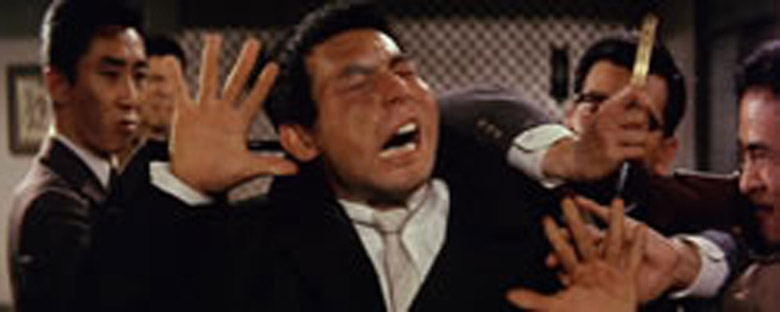Reviews
Yaju no seishun
Seijun Suzuki
Japan, 1963
Credits
Review by Rumsey Taylor
Posted on 12 January 2005
Source The Criterion Collection DVD
Youth of the Beast is populated by noir archetypes. The men are armed, the women are plenty and anonymous, and everyone is involved in some network of corruption. Under the Nikkatsu banner, the Japanese studio that churned out some 100 of these yakuza pictures each year in the ‘60s, these are familiar components, and no other description may tempt interest other than who’s in it and how much violence is in store—which is always promised in a trailer for a Nikkatsu yakuza picture.
Youth of the Beast exceeds these familiar frills, however, because it pairs director Seijun Suzuki with his regular muse Joe Shishido. The two collaborated on Suzuki’s unqualified, weird masterpiece, Branded to Kill, and here their talents instill a cheap genre film with more flourish and virtuosity than the material warrants.
The plot is sufficiently convoluted, involving Joji’s (Joe) hiring as a hitman in a rather exceptional sequence in which he beats up a nightclub’s bouncer to exhibit his controlled hostility to the club’s mobster owners. He is also a former policeman, and is also hired by rival mobsters. This string of deceit, double-crossing, and eye-for-an-eye code of ethics (which is followed almost literally) hinges upon revelations delivered in the explosive finale, but this film is distinguished for the visual hallmarks that precede it.
Although Suzuki’s formidable staging and camera movement is regularly apparent in his work, he is extraordinarily inventive with color film stock (which is, of the four Suzuki films I have seen, best exemplified in Tokyo Drifter). Youth of the Beast inhabits moderately imagined Art Deco settings and accoutrements—well-lit nightclubs with two-way mirrors; supporting characters (most of them women) are dressed in a kaleidoscope; and at one point, a very stylish rotary phone—and its periphery is vibrant with color.
Such craft is, however, in service to what is still a strict genre picture. As noted in recent interviews available on the Criterion DVD, neither Suzuki nor Shishido have any pretenses as to the aesthetic merits of their work (which are numerous); Suzuki even admits the film’s title is meaningless. Even the bulbous-cheeked Shishido maintains the clever humor the two shared:
The most intense character in the movie is called “Hideo with the razor blade,” and is played by Tamio Kawaji. That character was amazing. I never saw such sharp acting as Tamio Kawaji’s.
We don’t do comments anymore, but you may contact us here or find us on Twitter or Facebook.



